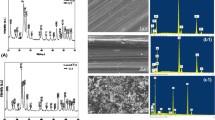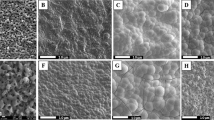Abstract
Nitinol, being a shape memory and super elastic alloy, is used in medical industry. Surface modification of nitinol helps to reduce the nickel ion leaching in physiological environment. The purpose of this study is to modify the nitinol surface by the silanization technique and to conduct a comparative investigation with the bare nitinol in the aspect of leaching of nickel ion, hemocompatibility, and in vivo animal response. X-ray photoelectron spectroscopy and energy dispersive X-ray spectroscopy studies confirmed the addition of organofunctional alkoxysilane molecules through the silanization process. The histological study showed the presence of adequate number of osteoblasts in silanized nitinol. The fluorochrome labeling study depicted more new bone formation (8 and 21% higher) in silanized nitinol specimens than bare one at one and three months postoperatively. Radiology and SEM study also proved the better performance of silanized samples. The cumulative in vivo results indicate its suitability as the potential bioimplant in various orthopedic surgical uses.









Similar content being viewed by others
References
T.W. Duerig, A. Pelton, and D. Stokel: An overview of nitinol medical applications. Mater. Sci. Eng., A 273, 149 (1999).
W. Chrzanowski, W. Walke, D.A. Armitage, and J.C. Knowles: Study on bioactivity of NiTinol after surface treatment. Arch. Mater. Sci. 6, 6 (2008).
S. Kobayashi, Y. Ohgoe, K. Ozeki, K. Sato, T. Sumiya, K.K. Hirakuri, and H. Aoki: Diamond-like carbon coatings on orthodontic archwires. Diamond Relat. Mater. 14, 1094 (2005).
S. Kujala: Biocompatibility and Biomechanical Aspects of Nitinol Shape Memory Metal Implants (Oulu University Press, Oulu Finland, 2003).
D.T.K. Kwok, M. Schulz, T. Hu, C. Chu, and P. Chu: Surface treatments of nearly equiatomic NiTi alloy (nitinol) for surgical implants. In Biomedical Engineering, Trends in Materials Science, A. Laskovski, (Ed.) Vol. 269 (InTech, Intechoopen, London, United Kingdom, 2011); p. 282.
S.A. Shabalovskaya: Physicochemical and biological aspects of nitinol as a biomaterial. Int. Mater. Rev. 46, 233 (2001).
N.B. Morgan: Medical shape memory alloy applications at the market and its products. Materi. Sci. Eng., A 378, 16 (2004).
S.A. Shabalovskaya: Surface, corrosion and biocompatibility aspects of nitinol as an implant material. Bio-Med. Mater. Eng. 12, 69 (2002).
S.A. Bernard, V.K. Balla, N.M. Davies, S. Bose, and A. Bandyopadhyay: Bone cell-materials interactions and Ni ion release of anodized equiatomic NiTi alloy. Acta Biomater. 7, 1902 (2011).
R.D. Barrett, S.E. Bishara, and J.K. Quinn: Biodegradation of orthodontic appliances. Part I. Biodegradation of nickel and chromium in vitro. Am. J. Orthod. Dentofac. Orthop. 103, 8 (1993).
J. Katić, M. Metikoš-Huković, R. Babić, and M. Marciuš: Sol–gel derived biphasic calcium phosphate ceramics on nitinol for medical applications. Int. J. Electrochem. Sci. 8, 1394 (2013).
G. Rondelli: Corrosion resistance tests on NiTi shape memory alloy. Biomaterials 17, 2003 (1996).
C. Trepanier, R. Venugopalan, and A.R. Pelton: Corrosion resistance and biocompatibility of passivated NiTi. In Shape Memory Implants, L. Yahia, (Ed.) Vol. 35 (Springer, Berlin, Heidelberg, New York, 2000).
P. Gill, V. Musaramthota, N. Munroe, A. Datye, R. Dua, W. Haider, A. McGoron, and R. Rokicki: Surface modification of Ni–Ti alloys for stent application after magnetoelectropolishing. Mater. Sci. Eng., C 50, 37 (2015).
Y.W. Gu, B.Y. Tay, C.S. Lim, and M.S. Yong: Biomimetic deposition of apatite coating on surface-modified NiTi alloy. Biomaterials 26, 6916 (2005).
J.H. Kim, J.H. Shin, D.H. Shin, M.W. Moon, K. Park, T.H. Kim, K.M. Shin, Y.H. Won, D.K. Han, and K.R. Lee: Comparison of diamond-like carbon-coated nitinol stents with or without polyethylene glycol grafting and uncoated nitinol stents in a canine iliac artery model. Br. J. Radiol. 84, 210 (2011).
X. Kong, R.G. Grabitz, W. Van Oeveren, D. Klee, T.G. Van Kooten, F. Freudenthal, M. Qing, G. Von Bernuth, and M.C. Seghaye: Effect of biologically active coating on biocompatibility of nitinol devices designed for the closure of intra-atrial communications. Biomaterials 23, 1775 (2002).
J. Lahann, D. Klee, W. Pluester, and H. Hoecker: Bioactive immobilization of r-hirudin on CVD-coated metallic implant devices. Biomaterials 22, 817 (2001).
V. Muhonen, S. Kujala, A. Vuotikka, V. Äaritalo, T. Peltola, S. Areva, T. Närhi, and J. Tuukkanen: Biocompatibility of sol–gel-derived titania-silica coated intramedullary NiTi nails. Acta Biomater. 5, 785 (2009).
L.M. Pérez, M. Arruebo, S. Irusta, L. Gracia-Villa, J. Santamaría, and J.A. Puértolas: Mechanochemical characterisation of silica-based coatings on nitinol substrates. Microporous Mesoporous Mater. 98, 292 (2007).
Y. Shen, G. Wang, L. Chen, H. Li, P. Yu, M. Bai, Q. Zhang, J. Lee, and Q. Yu: Investigation of surface endothelialization on biomedical nitinol (NiTi) alloy: Effects of surface micropatterning combined with plasma nanocoatings. Acta Biomater. 5, 3593 (2009).
S.M.A. Shibli, K.S. Beenakumari, and N.D. Suma: Nano nickel oxide/nickel incorporated nickel composite coating for sensing and estimation of acetylcholine. Biosens. Bioelectron. 22, 633 (2006).
C.J. Tang, G.X. Wang, Y. Shen, L.J. Wan, L. Xiao, Q. Zhang, Q.S. Yu, L.S. Liu, and G.B. Wen: A study on surface endothelialization of plasma coated intravascular stents. Surf. Coat. Technol. 204, 1487 (2010).
D. Tolomeo, T. Slater, and P. Wu: Predictive modelling of radial strength for superelastic stents. In SMST-2000: Proceedings of the International Conference on Shape Memory and Superelastic Technologies, S.M. Russell and A.R. Pelton, eds. (International Organization on SMST, Pacific Grove, California, 2000); p. 517.
K.W.K. Yeung, R.W.Y. Poon, X.M. Liu, P.K. Chu, C.Y. Chung, X.Y. Liu, S. Chan, W.W. Lu, D. Chan, and K.D.K. Luk: Nitrogen plasma-implanted nickel titanium alloys for orthopedic use. Surf. Coat. Technol. 201, 5607 (2007).
R. Bakhshi, A. Darbyshire, J.E. Evans, Z. You, J. Lu, and A.M. Seifalian: Polymeric coating of surface modified nitinol stent with POSS-nanocomposite polymer. Colloids Surf., B 86, 93 (2011).
P. Dubruel, E. Vanderleyden, M. Bergada, I. De Paepe, H. Chen, S. Kuypers, J. Luyten, J. Schrooten, L. Van Hoorebeke, and E. Schacht: Comparative study of silanization reactions for the biofunctionalisation of Ti-surfaces. Surf. Sci. 600, 2562 (2006).
H.R. Bakhsheshi-Rad, E. Hamzah, M. Daroonparvar, M.A.M. Yajid, M. Kasiri-Asgarani, M.R. Abdul-Kadir, and M. Medraj: In vitro degradation behavior of Mg alloy coated by fluorine doped hydroxyapatite and calcium deficient hydroxyapatite. Trans. Nonferrous Met. Soc. China 24, 2516 (2014).
H.Y. Yeh and J.C. Lin: Bioactivity and platelet adhesion study of a human thrombomodulin-immobilized nitinol surface. J. Biomater. Sci., Polym. Ed. 20, 807 (2009).
H. Yu, J. Yan, H. Ma, X. Zeng, Y. Liu, and X. Zhao: Creating poly(ethylene glycol) film on the surface of NiTi alloy by gamma irradiation. Radiat. Phys. Chem. 112, 199 (2015).
W. Haider, N. Munroe, V. Tek, P.K.S. Gill, Y. Tang, and A.J. McGoron: Cytotoxicity of metal ions released from nitinol alloys on endothelial cells. J. Mater. Eng. Perform. 20, 816 (2011).
C.T. Kao, S.J. Ding, H. He, M.Y. Chou, and T.H. Huang: Cytotoxicity of orthodontic wire corroded in fluoride solution in vitro. Angle Orthod. 77, 349 (2007).
R.E. McMahon, J. Ma, S.V. Verkhoturov, D. Munoz-Pinto, I. Karaman, F. Rubitschek, H.J. Maier, and M.S. Hahn: A comparative study of the cytotoxicity and corrosion resistance of nickel–titanium and titanium–niobium shape memory alloys. Acta Biomater. 8, 2863 (2012).
C. Pulletikurthi, P.M. Gill, S. Pandya, D. Persaud, W. Haider, K. Iyer, and A. McGoron: Cytotoxicity of Ni from surface-treated porous nitinol (PNT) on osteoblast cells. J. Mater. Eng. Perform. 20, 824 (2011).
A. Oyane, H.M. Kim, T. Furuya, T. Kokubo, T. Miyazaki, and T. Nakamura: Preparation and assessment of revised simulated body fluids. J. Biomed. Mater. Res., Part A 65, 188 (2003).
A.A. Green: The preparation of acetate and phosphate buffer solutions of known pH and ionic strength. J. Am. Chem. Soc. 55, 2331 (1933).
S.K. Nandi, S.K. Ghosh, B. Kundu, D.K. De, and D. Basu: Evaluation of new porous β-tri-calcium phosphate ceramic as bone substitute in goat model. Small Rumin. Res. 75, 144 (2008).
R.K. Roy, H.W. Choi, J.W. Yi, M.W. Moon, K.R. Lee, D.K. Han, J.H. Shin, A. Kamijo, and T. Hasebe: Hemocompatibility of surface-modified, silicon-incorporated, diamond-like carbon films. Acta Biomater. 5, 249 (2009).
S.A. Shabalovskaya, D. Siegismund, E. Heurich, and M. Rettenmayr: Evaluation of wettability and surface energy of native nitinol surfaces in relation to hemocompatibility. Mater. Sci. Eng., C 33, 127 (2013).
S. Sinha, P.C. Pramanik, H. Begam, and A. Chanda: Study on the effect of strain rate and temperature on mechanical properties of nitinol. Appl. Mech. Mater. 592, 1185 (2014).
G.R. Beck, S.W. Ha, C.E. Camalier, M. Yamaguchi, Y. Li, J.K. Lee, and M.N. Weitzmann: Bioactive silica-based nanoparticles stimulate bone-forming osteoblasts, suppress bone-resorbing osteoclasts, and enhance bone mineral density in vivo. Nanomed.: Nanotechnol. Biol. Med. 8, 793 (2012).
E.M. Carlisle: In vivo requirement for silicon in articular cartilage and connective tissue formation in the chick. J. Nutr. 106, 478 (1976).
E.M. Carlisle: Silicon: A requirement in bone formation independent of vitamin D1. Calcif. Tissue Int. 33, 27 (1981).
E.M. Carlisle: Silicon as an essential trace element in animal nutrition. Silicon Biochem. 703, 123 (2008).
R. Jugdaohsingh: Silicon and bone health. J. Nutr. Health Aging 11, 99 (2007).
Ž. Mladenović, A. Johansson, B. Willman, K. Shahabi, E. Björn, and M. Ransjö: Soluble silica inhibits osteoclast formation and bone resorption in vitro. Acta Biomater. 10, 406 (2014).
C.T. Price, K.J. Koval, and J.R. Langford: Silicon: A review of its potential role in prevention and treatment of postmenopausal osteoporosis. Int. J. Endocrinol. 2013, 1 (2013).
D.M. Reffitt, N. Ogston, R. Jugdaohsingh, H.F.J. Cheung, B.A.J. Evans, R.P.H. Thompson, J.J. Powell, and G.N. Hampson: Orthosilicic acid stimulates collagen type 1 synthesis and osteoblastic differentiation in human osteoblast-like cells in vitro. Bone 32, 127 (2003).
K. Schwarz: A bound form of silicon in glycosaminoglycans and polyuronides. Proc. Natl. Acad. Sci. U. S. A. 70, 1608 (1973).
ACKNOWLEDGMENTS
One of the authors (Sarmita Sinha) would like to acknowledge Council of Scientific and Industrial Research for financial support. The authors also acknowledge support from Mechanical Engineering Department and School of Bio Science & Engineering, Jadavpur University, Kolkata. The kind support from the Honorable Vice Chancellor, West Bengal University of Animal and Fishery Sciences, is gratefully acknowledged.
Author information
Authors and Affiliations
Corresponding authors
Rights and permissions
About this article
Cite this article
Sinha, S., Begam, H., Kumar, V. et al. Improved performance of the functionalized nitinol as a prospective bone implant material. Journal of Materials Research 33, 2554–2564 (2018). https://doi.org/10.1557/jmr.2018.204
Received:
Accepted:
Published:
Issue Date:
DOI: https://doi.org/10.1557/jmr.2018.204




